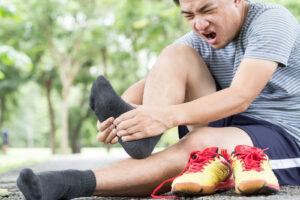Shin splints – you’re just getting into the swing of footy season or really stringing together some good runs over a few weeks. You start to run and all of a sudden after some time you feel an irritating pain in the inside of your shins.
You try to run through it but it just continues to get worse. So you walk off the ground or walk home unable to finish what you started.
If this sounds like something you’ve experienced. It’s likely that you have shin splints.
What are shin splints?
Shin splints occur when the muscles and bony tissue called the periosteum become overworked through repetitive forms of exercise. There may be some inflammation associated with that as well. Often there will be a change in a person’s activities or an increase in load.
For example, the frequency of which you exercise (going from 2 days to 5 days), duration (30 mins running to an 1 hour), intensity (running on flat to hilly terrain). These are just a few examples of changes that can stir up shin splints.
Other factors that can cause shin splints may include gait related factors such as “Flat Feet”, inability to absorb shock, worn out or unsupportive footwear, tight calf muscles.
So how do we go about “fixing” shin splints?
First and foremost is to load manage. By that we mean, to reduce our current running loads or amount of training that we’re doing. Reduce your loads by roughly 50% to start, as you start to feel better you will be able to SLOWLY increase your training volume by no more than 10% a week.
Another aspect to address is those tight calves, in particular the soleus muscle. The best way to stretch the soleus muscle is any calf stretch with a bent knee.
- Stand with your hands against a wall or the back of a chair for support.
- Put one foot behind you. Keep your feet flat and pointed straight ahead.
- Bend your front knee slightly. With your back heel down, bend your back knee. If it’s too hard to keep your heel down, shorten your stride.
- Hold the stretch for at least 30 seconds. Repeat the stretch 2 or 3 times, and aim for stretching 3 times a day.
Lastly, you may need to address your footwear or even need the aid of orthotics if this has been a long lasting issue. A couple of things to consider when looking for shoes. Assuring the shoes aren’t too flat. The flatter the shoe, the more likely you are to exacerbate your symptoms.
Likewise, you may find you need a more ‘supportive’ shoe which helps to reduce ‘pronation’ and absorb impact more comfortably. If you’re unsure about orthotics the best way to know if you’re a candidate for them is to see your local podiatrist.
What we’ve discussed is just a starting point. You may find you need the help of a few other treatment modalities such as RICER, dry needling and massage.
If you have any other questions, be sure to let us know!
